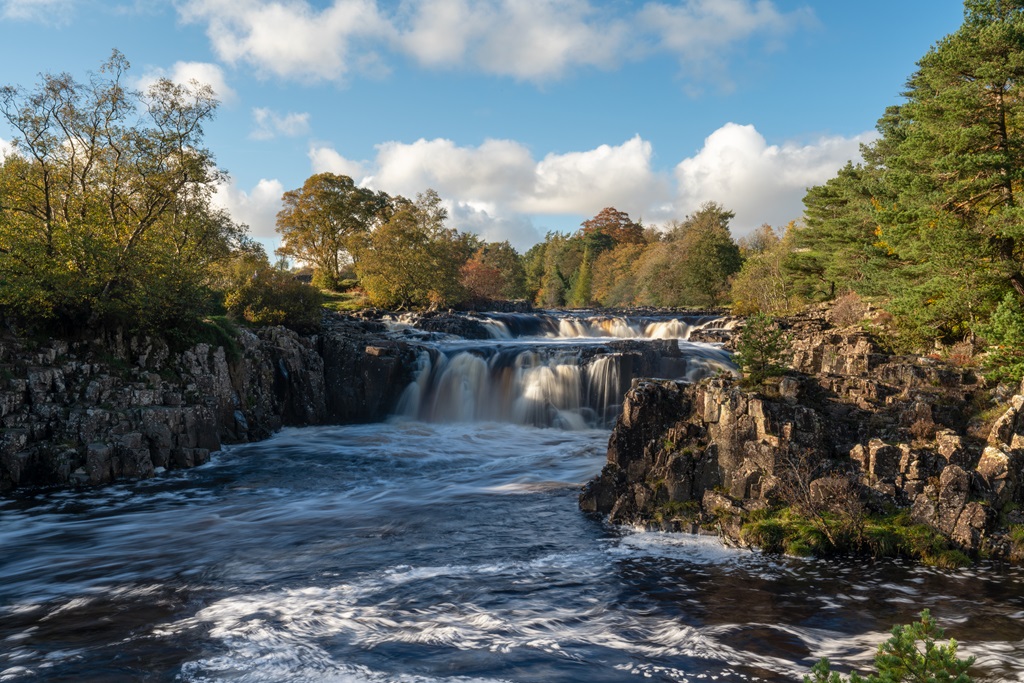|
Holwick
Holwick is a hamlet and civil parish in Teesdale, County Durham (district), England. Located in the Pennine hills, the hamlet consists of a few houses spread along a road in the pattern of a linear settlement. The population of the parish taken at the 2021 Census was 75. Being south of the River Tees, Holwick lies within the historic boundaries of the North Riding of Yorkshire. Along with the rest of the former Startforth Rural District it was transferred to County Durham for administrative and ceremonial purposes on 1 April 1974, under the provisions of the Local Government Act 1972. In May 2013, the newly registered flag of the North Riding was first unveiled at the village, owing to its being one of the most northerly settlements in Yorkshire. It has a public house, the ''Strathmore Arms'', named after local landowner, Lord Strathmore, who owned Holwick Hall. New York businessman Harry Payne Whitney leased Holwick Hall for a grouse shooting party on the moors in 1911, ... [...More Info...] [...Related Items...] OR: [Wikipedia] [Google] [Baidu] |
Startforth Rural District
Startforth Rural District was a rural district in the North Riding of the historic county of Yorkshire in the Pennines of northern England. It was formed in 1894 under the Local Government Act 1894. It constituted the part of the Teesdale Rural Sanitary District that was in the North Riding (the rest being in County Durham). In 1974, the district was abolished and became, for administrative purposes, part of the Teesdale district of the non-metropolitan county of County Durham. It comprised the area south of the River Tees between Cow Green Reservoir and Gainford, and north of the modern administrative border between County Durham and North Yorkshire. The area is hilly and fairly sparsely populated. Places within it included; Villages * Barningham * Boldron * Bowbank *Bowes * Brignall * Cotherstone * Gilmonby * Grassholme * Greta Bridge * Hutton Magna * Holwick * Hunderthwaite * Hury * Lartington * Mickleton * Ovington *Romaldkirk * Scargill * Startforth *Thringarth * Wycli ... [...More Info...] [...Related Items...] OR: [Wikipedia] [Google] [Baidu] |
Newbiggin, Teesdale
Newbiggin is a village and civil parish in County Durham, England. At the 2011 census the parish had a population of 146. It is situated on the north side of Teesdale, opposite Holwick. An influx of Derbyshire lead miners into the area in the late 18th century may have brought the name from Biggin. The village is within the North Pennines Area of Outstanding Natural Beauty (AONB). The village of Newbiggin is up the River Tees from the incredible High Force, one of England's most impressive waterfalls. The hamlet of Bowlees is close by. Newbiggin was formerly a township in the parish of Middleton-in-Teesdale, but in 1866 became a separate civil parish. A Methodist chapel was built in the village in 1760. It is now a holiday let known as Newbiggin Chapel. For many years it was said to be one of the oldest Methodist chapel in continuous use. It is a Grade II listed building In the United Kingdom, a listed building is a structure of particular architectural or histori ... [...More Info...] [...Related Items...] OR: [Wikipedia] [Google] [Baidu] |
County Durham
County Durham, officially simply Durham, is a ceremonial county in North East England.UK General Acts 1997 c. 23Lieutenancies Act 1997 Schedule 1(3). From legislation.gov.uk, retrieved 6 April 2022. The county borders Northumberland and Tyne and Wear to the north, the North Sea to the east, North Yorkshire to the south, and Cumbria to the west. The largest settlement is Darlington. The county has an area of and a population of . The latter is concentrated in the east; the south-east is part of the Teesside urban area, which extends into North Yorkshire. After Darlington, the largest settlements are Hartlepool, Stockton-on-Tees, and Durham, England, Durham. For Local government in England, local government purposes the county consists of the Unitary authorities of England, unitary authority areas of County Durham (district), County Durham, Borough of Darlington, Darlington, Borough of Hartlepool, Hartlepool, and part of Borough of Stockton-on-Tees, Stockton-on-Tees. Durham Count ... [...More Info...] [...Related Items...] OR: [Wikipedia] [Google] [Baidu] |
George VI
George VI (Albert Frederick Arthur George; 14 December 1895 – 6 February 1952) was King of the United Kingdom and the Dominions of the British Commonwealth from 11 December 1936 until Death and state funeral of George VI, his death in 1952. He was also the last Emperor of India from 1936 until the British Raj was dissolved in August 1947, and the first head of the Commonwealth following the London Declaration of 1949. The future George VI was born during the reign of his great-grandmother Queen Victoria; he was named Albert at birth after his great-grandfather Prince Albert of Saxe-Coburg and Gotha and was known as "Bertie" to his family and close friends. His father ascended the throne as George V in 1910. As the second son of the king, Albert was not expected to inherit the throne. He spent his early life in the shadow of his elder brother, Edward VIII, Edward, the heir apparent. Albert attended naval college as a teenager and served in the Royal Navy and Royal Air Force ... [...More Info...] [...Related Items...] OR: [Wikipedia] [Google] [Baidu] |
Neolithic
The Neolithic or New Stone Age (from Ancient Greek, Greek 'new' and 'stone') is an archaeological period, the final division of the Stone Age in Mesopotamia, Asia, Europe and Africa (c. 10,000 BCE to c. 2,000 BCE). It saw the Neolithic Revolution, a wide-ranging set of developments that appear to have arisen independently in several parts of the world. This "Neolithic package" included the History of agriculture, introduction of farming, domestication of animals, and change from a hunter-gatherer lifestyle to one of sedentism, settlement. The term 'Neolithic' was coined by John Lubbock, 1st Baron Avebury, Sir John Lubbock in 1865 as a refinement of the three-age system. The Neolithic began about 12,000 years ago, when farming appeared in the Epipalaeolithic Near East and Mesopotamia, and later in other parts of the world. It lasted in the Near East until the transitional period of the Chalcolithic (Copper Age) from about 6,500 years ago (4500 BCE), marked by the development ... [...More Info...] [...Related Items...] OR: [Wikipedia] [Google] [Baidu] |
Microlith
A microlith is a small Rock (geology), stone tool usually made of flint or chert and typically a centimetre or so in length and half a centimetre wide. They were made by humans from around 60,000 years ago, across Europe, Africa, Asia and Australia. The microliths were used in spear points and arrowheads. Microliths are produced from either a small blade (Microblade technology, microblade) or a larger blade-like piece of flint by abrupt or truncated retouch (lithics), retouching, which leaves a very typical piece of waste, called a microburin. The microliths themselves are sufficiently worked so as to be distinguishable from workshop waste or accidents. Two families of microliths are usually defined: laminar and geometric. An assemblage of microliths can be used to date an archeological site. Laminar microliths are slightly larger, and are associated with the end of the Upper Paleolithic and the beginning of the Epipaleolithic era; geometric microliths are characteristic of the M ... [...More Info...] [...Related Items...] OR: [Wikipedia] [Google] [Baidu] |
Mesolithic
The Mesolithic (Ancient Greek language, Greek: μέσος, ''mesos'' 'middle' + λίθος, ''lithos'' 'stone') or Middle Stone Age is the Old World archaeological period between the Upper Paleolithic and the Neolithic. The term Epipaleolithic is often used synonymously, especially for outside northern Europe, and for the corresponding period in Epipaleolithic Near East, the Levant and Epipaleolithic Caucasus, Caucasus. The Mesolithic has different time spans in different parts of Eurasia. It refers to the final period of hunter-gatherer cultures in Europe and the Middle East, between the end of the Last Glacial Maximum and the Neolithic Revolution. In Europe it spans roughly 15,000 to 5,000 Before Present, BP; in the Middle East (the Epipalaeolithic Near East) roughly 20,000 to 10,000 Before Present, BP. The term is less used of areas farther east, and not at all beyond Eurasia and North Africa. The type of culture associated with the Mesolithic varies between areas, b ... [...More Info...] [...Related Items...] OR: [Wikipedia] [Google] [Baidu] |
Fell
A fell (from Old Norse ''fell'', ''fjall'', "mountain"Falk and Torp (2006:161).) is a high and barren landscape feature, such as a mountain or Moorland, moor-covered hill. The term is most often employed in Fennoscandia, Iceland, the Isle of Man, parts of northern England, and Scotland. Etymology The English word "fell" comes from Old Norse ''fell'' and ''fjall'' (both forms existed). It is cognate with Danish language, Danish ''fjeld'', Faroese language, Faroese ''fjall'' and ''fjøll'', Icelandic language, Icelandic ''fjall'' and ''fell'', Norwegian language, Norwegian ''fjell'' with Norwegian dialects, dialects ''fjøll'', ''fjødd'', ''fjedd'', ''fjedl'', ''fjill'', ''fil(l)'', and ''fel'', and Swedish language, Swedish ''fjäll'', all referring to mountains rising above the Tree line, alpine tree line.Bjorvand and Lindeman (2007:270–271). British Isles In northern England, especially in the Lake District and in the Pennines, Pennine Dale (origin), Dales, the wor ... [...More Info...] [...Related Items...] OR: [Wikipedia] [Google] [Baidu] |
Moorland
Moorland or moor is a type of Habitat (ecology), habitat found in upland (geology), upland areas in temperate grasslands, savannas, and shrublands and the biomes of montane grasslands and shrublands, characterised by low-growing vegetation on Soil pH, acidic soils. Moorland today generally means uncultivated hill land (such as Dartmoor in South West England), but also includes low-lying wetlands (such as Sedgemoor, also South West England). It is closely related to heath, although experts disagree on the exact distinction between these types of vegetation. Generally, moor refers to Highland (geography), highland and high rainfall areas, while heath refers to lowland zones which are more likely to be the result of human activity. Moorland habitats are found mainly in Tropics, tropical Africa, Northern Europe, northern and western Europe, and South America. Most of the world's moorlands are diverse ecosystems. In the extensive moorlands of the tropics, biodiversity can be extremely ... [...More Info...] [...Related Items...] OR: [Wikipedia] [Google] [Baidu] |
Waterfall
A waterfall is any point in a river or stream where water flows over a vertical drop or a series of steep drops. Waterfalls also occur where meltwater drops over the edge of a tabular iceberg or ice shelf. Waterfalls can be formed in several ways, but the most common method of formation is that a river courses over a top layer of resistant bedrock before falling onto softer rock, which erodes faster, leading to an increasingly high fall. Waterfalls have been studied for their impact on species living in and around them. Humans have had a distinct relationship with waterfalls since prehistory, travelling to see them, exploring and naming them. They can present formidable barriers to navigation along rivers. Waterfalls are religious sites in many cultures. Since the 18th century, they have received increased attention as tourist destinations, sources of hydropower, andparticularly since the mid-20th centuryas subjects of research. Definition and terminology A waterfal ... [...More Info...] [...Related Items...] OR: [Wikipedia] [Google] [Baidu] |
Low Force
Low Force is an 18-foot (5.5m) high set of falls on the River Tees, England, UK. Further upstream is the High Force waterfall. Low Force is also the site of the Wynch Bridge, completed in 1830. It is suggested by signs at each end that only one person at a time should cross the bridge as it may be unstable. Geography Low Force is within the North Pennines Area of Outstanding Natural Beauty ( AONB) and European Geopark. Low Force lies on the historic county boundary between the North Riding of Yorkshire on the south bank, and County Durham on the north bank; since the local government reforms of 1974, however, the south bank of the Tees in Teesdale has also been included within County Durham for administrative purposes. In popular culture Sections of the film ''1917'' were shot near the site in June 2019. The production staff had to install signs warning walkers in the area not to be alarmed at the prosthetic bodies strewn around the site. In 2020 production crews arrived on ... [...More Info...] [...Related Items...] OR: [Wikipedia] [Google] [Baidu] |
High Force
High Force is a waterfall on the River Tees, near Middleton-in-Teesdale, Teesdale, England. The waterfall is within the North Pennines Area of Outstanding Natural Beauty (AONB) and the European Geopark. The whole of the River Tees plunges over a precipice (an almost vertical cliff edge) in two stages. After heavy rainfall the river will also flow over the usually dry right-hand side channel, creating two falls. Very occasionally the river level will be high enough to flow over the central section of rock; the last recorded time this happened was in December 2015 after Storm Desmond. In harsh winters the falls have been known to freeze, creating cathedral-like ice formations. Access to the northern bank is via a private footpath on the Raby Castle, Raby estate for which a fee is charged. The southern bank can be reached free of charge via the Pennine Way public footpath which crosses the Moor House-Upper Teesdale National Nature Reserve. Geology High Force was formed where th ... [...More Info...] [...Related Items...] OR: [Wikipedia] [Google] [Baidu] |







